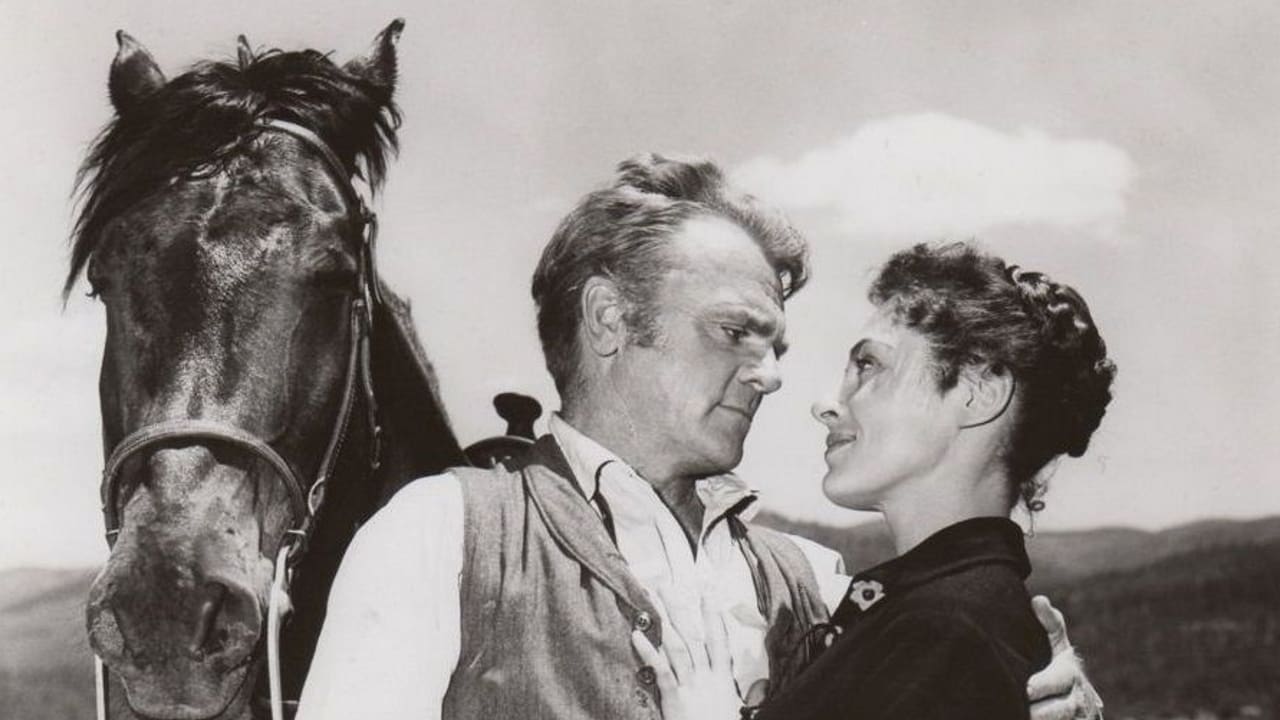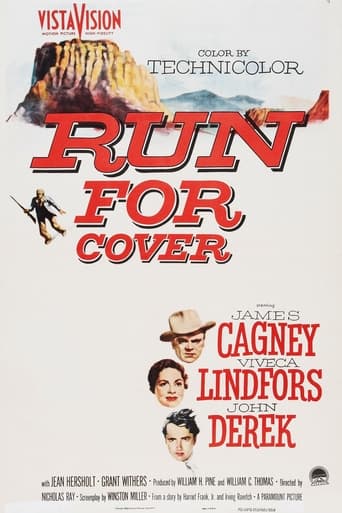



Beautiful, moving film.
n my opinion it was a great movie with some interesting elements, even though having some plot holes and the ending probably was just too messy and crammed together, but still fun to watch and not your casual movie that is similar to all other ones.
View MoreWhile it doesn't offer any answers, it both thrills and makes you think.
View MoreThis is a small, humorous movie in some ways, but it has a huge heart. What a nice experience.
View MoreA rather maddening western. Apparently Paramount went all out for an oater, filming in gorgeous southwestern Colorado and Aztec ruins of northwestern New Mexico. In short, there's plenty of scenic eye candy, while if there's a studio set anywhere, I couldn't spot it. Then too, there's A-list Cagney, maybe on the aging downgrade, but still Cagney. Seems he's trying to rehabilitate young man Derek from both a leg wound and a checkered past. As the new town sheriff facing a band of outlaws, an unreliable deputy Derek, and a pack of town ruffians, he's got his work cut out.As I see it, there's a problem with the screenplay—it's too loose and lacking in focus, rambling from one incident to the next in no particular order. Thus, neither tension nor suspense builds over time nor into the rather poorly staged climax. I suspect Paramount was trying to cater to Cagney's starring presence since he's in about every scene. He's his usual commanding self. However, that's part of the problem since Derek lacks the presence needed to create chemistry with the older, compelling man. Thus, their scenes together appear lop-sided in the extreme, and the heart of the movie fails to gel.I guess the studio figured young Derek's wayward role was apt material for brilliant director Nick Ray, who's specialty was troubled youth, i.e. They Live By Night (1948), Knock On Any Door (1949). Then too, Ray would soon triumph in the following year's iconic youth film, Rebel Without A Cause (1955). Unfortunately, I don't see any of his usual brilliance here, and I suspect he was neutralized by the rambling script and an A-list star. Though myopic editing may have figured, as it does in the river swim which strangely lacks any sequential coherence.All in all, the 93-minutes amounts to a disappointment given the production values and talent involved. In my view, the best parts are those lushly vivid scenes from Colorado's Rockies and rivers.
View MoreRun for Cover (1955)The first reason to see this is the simple fact it's a Nicholas Ray movie. Ray didn't direct many movies, but among those few are some of the best--or at least my favorites--in the whole history of Hollywood. "They Live by Night" and "In a Lonely Place" are moving and interesting masterpieces, and "Johnny Guitar" is completely bizarre and original and a wild ride. Only slightly less interesting to me but more iconic is "Rebel without a Cause," made the same year as this one."Run for Cover" is an awkward fit, a Western by a director of mostly urban dramas. James Cagney isn't really cast wrong, per se, because he's presented as an outsider in this typical rough frontier town, but he comes off a little superficial, using his razor fast approach as an end rather than a means. And I think this is because the story is weak. It sounds good on paper, but it unfolds a little obviously, with some filler and some seemingly requisite but boring views of beautiful landscapes. There are gunfights, a run-in with Indians, and deception. It's a story without emotional subtlety and Ray is best a peeling back layers in human interaction, not just showing the action.Even the interesting Viveca Lindfors (who originally led me to the movie after seeing her in "Backfire," is oddly stiff, doubly odd because she's a Swedish immigrant playing a Swedish immigrant. You get the feeling she was never a poor farmer back home.I don't mean to pile on criticisms, but it's worth saying that the direction isn't good, either. The filming is dull, there are a couple of odd moments like when a big log suddenly appears in the river to save someone, and sometimes the cuts don't match one to the next. I'm guessing there's a deeper story to the awkwardness here, but all we have is the awkwardness.Not that it's a disaster. I watched the whole thing, and the key theme of being honorable even when being misunderstood is good. And a really nasty deception (or plain old ingratitude) is pulled off right before our eyes, more than once.. The filming location seems to be Colorado rather than California or Arizona (as many Westerns are), and that gives it a different feel. And there is a short section (out of nowhere) shot in an ancient Indian ruin in New Mexico, with good atmospherics. Plug your ears to some of the overdone music, and let the plot ride off a little on its own and there's a good chance you'll like a lot of this movie.
View MoreIf you've seen Jimmy Cagney in a few of his famous gangster roles, his appearance in a Western might be enough to make you scratch your head. I had that reaction the first time, when I caught him as a 'good' bad guy in "The Oklahoma Kid", opposite another actor you might peg the same way - Humphrey Bogart. That picture was filmed in 1939 and you had a much younger Cagney riding hell bent for leather and engaging in a wild saloon brawl with his co-star. Even so, he was forty years old at the time, while here, he's in his mid fifties and a bit slower on the draw as his character Matt Dow emphasizes a number of times. Cagney appears a bit more comfortable in his role here than he did as 'The Kid', in fact I did a few double takes as he resembled an older Audie Murphy a few times.The story has a couple of interesting turns, starting right out of the gate when Matt Dow hooks up with local cowpoke Davey Bishop, and they unwittingly fall into possession of a train payroll when two employees who have been robbed before under similar circumstances figure it would be easier to just give it up. Bishop is portrayed by John Derek, who I've seen in a few Westerns as well, and he too looks like he'd be more comfortable in a different type of film, say as an angst ridden youth or a slick motorcycle gang member. Although I did like him in "Fury at Showdown", another Western with a great brawl, maybe the best I've ever seen, if not the longest.While Bishop recovers from severe wounds received by the posse that hunted them down for the lost payroll, Cagney's character sparks up a romantic interest with the woman who nurses Bishop back to health. At first I wasn't sure if Helga Swenson (Viveca Lindfors) was using Matt to get to know Bishop better; she appeared a lot closer in age to the younger sidekick. I guess it could have been written either way, but this was Cagney's picture. It was clever the way Cagney's character got old man Swenson (Jean Hersholt) to allow Matt to earn his keep while Davey recovered. The old guy was pretty sharp though, he knew what Matt was doing the entire chess game before the subject of matrimony came up.The story got interesting with the robbery at the church service, leading to another twist in the story regarding Bishop's character. With greed winning out over his conscience, Bishop turns on his mentor, only to reverse himself in the finale. In a somewhat unusual ending, Matt comes through for the town folk once again, but at a price. You can see it coming, but it could have gone a couple of different ways, with the outcome another twist to your typical bad guy learning from his mistakes scenario.Here's something interesting about the casting for the picture - in Cagney's very first film, he portrayed a young hood who worked for a mobster played by Grant Withers. In this one, Withers is the outlaw who robbed the church goers. Funny how things go sometimes. The picture also offers a brief appearance by Ernest Borgnine, also as a bad guy taken out by Matt.The film was directed by Nicholas Ray, which helps explain some of the focus on John Derek's troubled character. For an even better Ray/Derek collaboration, you'll have to check out 1949's "Knock On Any Door", with Humphrey Bogart in the lead role. Derek portrays a young man with a criminal past who reaches the end of the line when he winds up killing a cop. For his part, Nicholas Ray marked the epitome of his directorial achievement with his epic story of teenage angst - "Rebel Without A Cause".
View More"Run for cover" occupies a curious place in Nicholas Ray's brilliant filmography.Sandwiched between "Johnny Guitar" and "Rebel without a cause,it suffered accordingly.They say Ray himself disliked it.And however,in "Run for cover" he opened up as he never did before.In "knock on any door" ,Ray had already displayed a "father" -"son" relationship between Bogart and John Derek (who takes on here roughly the same kind of part he played at the beginning of the fifties).Ray would reach his peak with the following work ("Rebel" ) where Plato wanted Jim to be his dad and began to think of a new family with his pal and Judy.Davey is a tragic character .He seems to be born under a bad sign ,he is known to have a very bad reputation wherever he goes.It's obvious in the scene of the train:whereas Matt (Cagney) wants to give the money back to the town,Davey is thinking of the life he could lead if this loot were his.Matt knows that Davey needs someone to become a man .Alone he would walk on crutches .His leg is a transparent metaphor.Maybe he thinks of a new family he would rebuild with Helga (Viceca Lindfords).The relationship between the mature man and the Swede is full of tenderness and human warmth,a permanent feature in Ray's canon (see the lovers of "they live by night" and the teenagers in " Rebel without a cause".Like Jeff in "lusty man",Matt had a raw deal and he wants to make the best of the years which he's still got to live.Jeff will help Wes become a man in the cruel world of rodeo,but it's a different matter with Davey Bishop (what a surname!).It's remarkable that violence appears twice after scenes depicting children: the first time when Matt is making a wooden gun for a boy ;the second time in the church as a choir of little boys and girls is singing a canticle to praise the Lord."Rebel without a cause" is probably Ray's most underrated work.Davey remains his most moving character ;without any mawkishness ,the director paints the picture of the rebel with a cause,who cannot understand why he should work for eight dollars a week when there's plenty of money to take.The last line is my favorite in any Ray movie.In its own special way,it preserves the viewer from despair.
View More